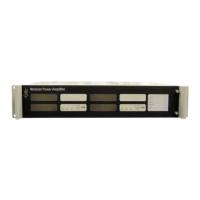iPAM400 – Product Manual
U-0629-0171.doc – Issue: 04 complete, approved
Page 20 of 138
2.4.3.1.1 Line Open Circuit Fault
The system reports a line open circuit fault when the DC surveillance indicates that the total number of
spurs has decreased below the commissioned value for the amplifier. The total number of spurs is the sum
of spurs commissioned for the amplifier slot.
Line open circuit fault for an amplifier is reported within 100 seconds of the fault being induced provided
that no partial or total short circuit faults have been reported for the amplifier.
The faulty loudspeaker circuit within an amplifier can be identified in the case of a single line open circuit
fault.
2.4.3.1.2 Partial Line Short Circuit Fault
The system reports a line short circuit fault when the DC surveillance indicates that the total number of
spurs appears to have increased above the commissioned value for the amplifier, i.e. the overall resistance
is lower, due to a partial short circuit. The total number of spurs is the sum of spurs commissioned for the
amplifier slot.
Line short circuit fault for the amplifier is reported within 100 seconds of the fault being induced provided
that no open circuit or total short circuit faults have been reported for the amplifier.
The faulty loudspeaker circuit within an amplifier can be identified in the case of a single partial line short
circuit fault.
2.4.3.1.3 Total Line Short Circuit Fault or Amplifier Failure
Amplifier failure is determined when the output surveillance level falls below the commissioned threshold
(60% of the measured value) AND the amplifier input surveillance is OK. This condition will also be caused
by a total short circuit on the amplifier output.
In order to differentiate between the two fault conditions the system isolates all outputs configured for the
amplifier, and then checks the output surveillance level:
• If the output surveillance level is now OK, then the fault is a line short and a line short circuit is
reported. After reporting the line short circuit fault the system determines which of the circuits the
short occurs on and isolate the faulty circuit(s).
In order to do this, the system removes the isolation and performs an output level measurement for
each circuit fed by the amplifier. If the output level is still OK then other circuit(s) fed by the amplifier is
faulty. If the reading is now below the commissioned threshold then the connected circuit is faulty, and
it is isolated again. Therefore all faulty circuits will be isolated and identified at the end of the
diagnostic process.
• If this is still below the commissioned threshold then an amplifier failure is reported and faulty
amplifier is switched over to the standby amplifier if a standby amplifier (internal or external) is
available.
Fault is reported within 100 seconds of the fault being induced.
The system performs this diagnostic process for an amplifier whenever it detects that the output
surveillance level is bellow the commissioned threshold AND the amplifier input surveillance is OK.

